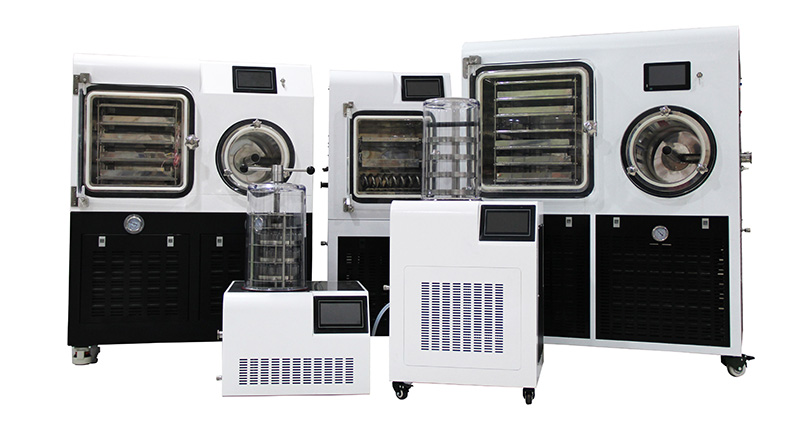The workflow of freeze-drying cordyceps using Shanghai Yetuo freeze-drying machine:
1. Prepare cordyceps samples: Choose fresh cordyceps mycelium or intact cordyceps fruiting bodies as samples. Ensure the quality and purity of the samples.
2. Pre treated samples: Pre treat cordyceps samples as needed. This may include steps such as cleaning, disinfection, cutting, or separation for better freeze-drying.
3. Sample installation: Evenly distribute the cordyceps sample in the tray or container of the freeze-drying machine. Ensure that the sample is not too dense to allow for air and cooling circulation.
4. Parameter setting: Based on the characteristics of cordyceps and the required freeze-drying conditions, set the temperature, vacuum degree, and time parameters of the freeze-drying machine. Usually, the temperature of the freeze dryer is set at a lower temperature to effectively freeze the sample.
5. Start the freeze-drying process: Start the freeze-drying machine to start working. Freeze drying gradually lowers the temperature and establishes a vacuum environment to convert the moisture in the sample into ice crystals, which are then directly transformed into a gaseous state through a sublimation process to achieve freeze-drying.
6. Monitor the freeze-drying process: Throughout the entire freeze-drying process, closely monitor the parameters of the freeze-drying machine, such as temperature, vacuum degree, and time. Ensure stable and smooth freeze-drying process.
7. Complete the freeze-drying process: Once the freeze-drying process is complete, turn off the freeze-drying machine and wait for the sample to reach room temperature. At this point, the cordyceps sample has been freeze-dried and can be taken out for further processing and storage.
Compared to drying, freeze-drying of cordyceps has the advantages of retaining more active ingredients, maintaining intact morphology and structure, extending shelf life, and improving solubility and stability. Details are as follows:
1. Retain active ingredients: Freeze drying is a low-temperature drying method that can remove moisture while maintaining the active ingredients of cordyceps samples. During the freeze-drying process, the bioactive substances in cordyceps, such as polysaccharides, triterpenoids, peptides, etc., are effectively retained through rapid freezing and vacuum dehydration. In contrast, the high temperature during the drying process may cause the degradation and loss of some thermosensitive components.
2. Maintain intact morphology and structure: During the freeze-drying process, the cordyceps sample is rapidly frozen at low temperatures and then dehydrated in a vacuum environment, which helps to maintain the morphology and cellular structure of the cordyceps sample. After freeze-drying, the appearance of cordyceps is intact, without obvious deformation, shrinkage, or color changes, maintaining its natural form and characteristics. During the drying process, due to the high temperature, the cordyceps samples may undergo deformation, shrinkage, and color changes, resulting in a decrease in appearance quality.
3. Extended shelf life: During the freeze-drying process, the moisture in cordyceps is completely removed, effectively reducing the conditions for microbial growth and thus extending the shelf life of cordyceps. Freeze dried cordyceps samples are relatively dry and less susceptible to contamination and growth by microorganisms such as mold and bacteria. Dried cordyceps, due to its high moisture content, is prone to the growth of mold and bacteria, leading to a decrease in quality and a shortened shelf life.
4. Improve solubility and stability: During the freeze-drying process, the soluble components in cordyceps are retained, resulting in better solubility and stability of freeze-dried cordyceps. Freeze dried cordyceps samples are relatively pure and free of moisture, making them easier to dissolve in solvents and facilitate further extraction and preparation. In addition, the low temperature environment during freeze-drying helps maintain the stability of some components in cordyceps, preventing their degradation and denaturation.


 Alibaba Store
Alibaba Store Tmall Store
Tmall Store Jingdong Sstore
Jingdong Sstore







